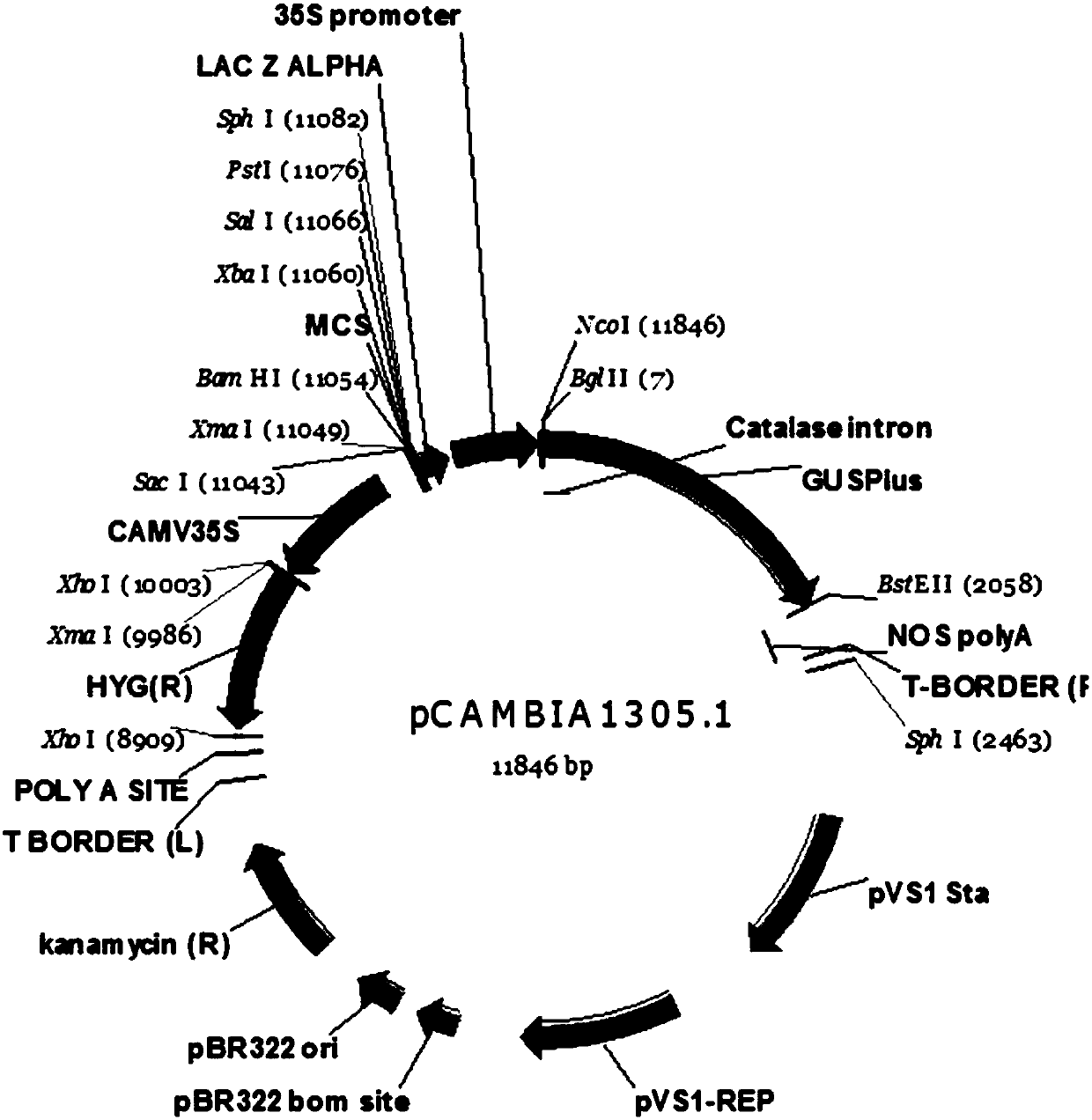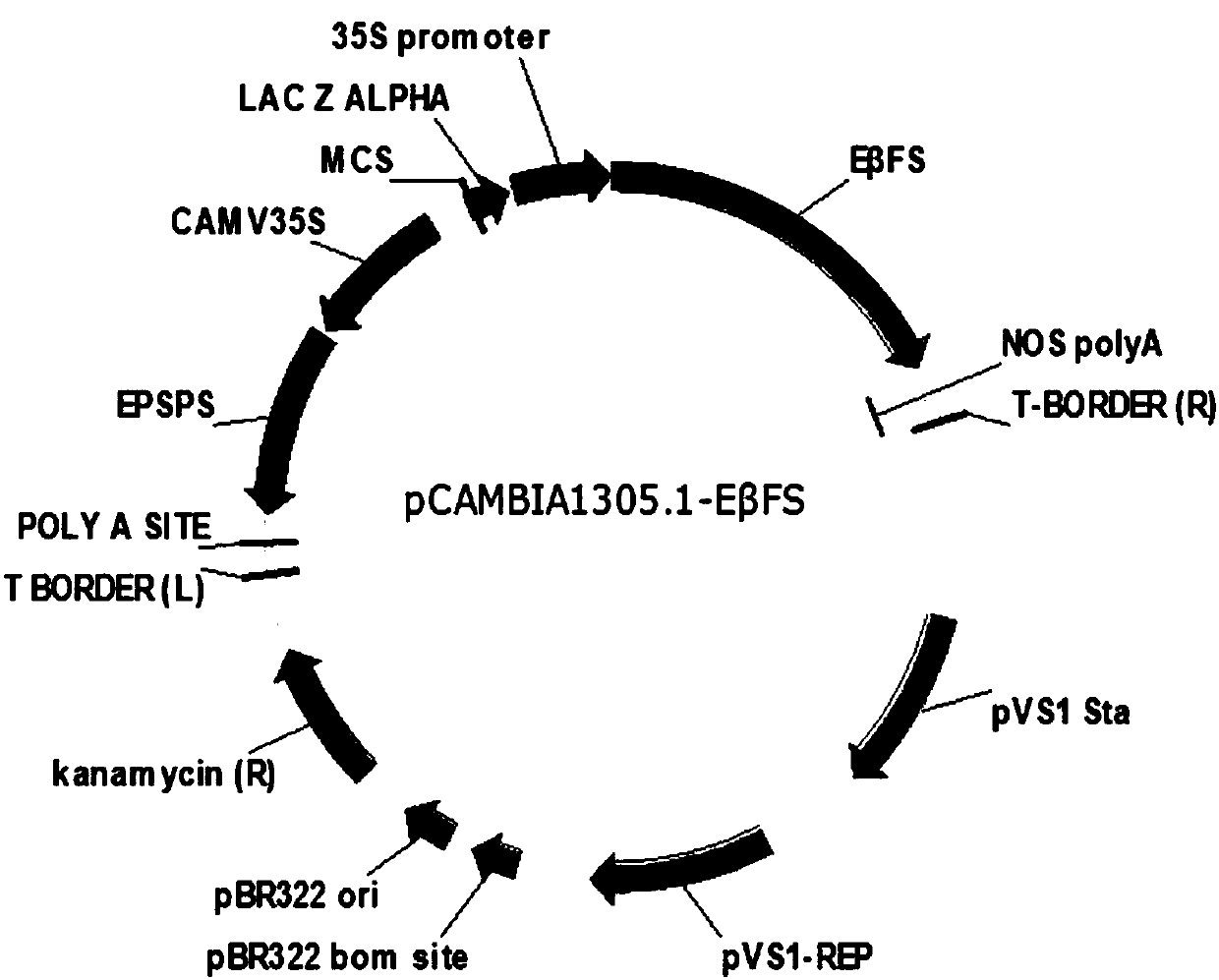Plant aphid resistance realization method based on 35S promoter
A promoter and plant technology, applied in the field of bioengineering, can solve problems such as pesticides easily polluting the environment, and achieve the effect of being conducive to popularization and low cost
- Summary
- Abstract
- Description
- Claims
- Application Information
AI Technical Summary
Problems solved by technology
Method used
Image
Examples
Embodiment 1
[0020] Cloning of EβF Gene of Peppermint
[0021] 1. Extraction of total RNA from the peppermint genome: Take the peppermint leaf tissue, grind it in liquid nitrogen, add it to a 1.5mL Eppendorf (EP) centrifuge tube filled with lysate, shake it fully, and follow the instructions in the TIANGEN kit. Instructions for extracting total RNA. The quality of total RNA was identified by agarose gel electrophoresis, and then the RNA content was determined on a spectrophotometer.
[0022] 2. Cloning of the peppermint EβF gene: using the extracted total RNA as a template, cDNA was synthesized under the action of PowerScript reverse transcriptase; gene-specific primers were designed according to the sequence of the EβF gene, and amplified from the total cDNA by PCR EβF gene, and sequenced.
[0023] Through the above steps, the full-length 1650bp of the peppermint EβF gene was obtained, its nucleotide sequence is shown in SEQ ID NO.1, and its protein coding sequence was deduced as shown ...
Embodiment 2
[0030] Construction of a plant overexpression vector containing the EβF gene: The partial sequence of the EβF gene was constructed on the transformed plant overexpression vector (pCAMBIA1305.1). In order to facilitate the construction of the expression vector, the forward primer introduced the NcoI enzyme cutting site point, the restriction site of BstEII was introduced in the reverse primer, and the primers are shown in Table 3;
[0031] Table 3 PCR primers constructed by pCAMBIA1305.1-EβF vector
[0032] Primer name
[0033] The plant overexpression vector pCAMBIA1305.1 after described transformation, all introduced the restriction site of XhoI in EPSPS gene forward primer and reverse primer in commercially available pCAMBIA1305 carrier, constructs the plant overexpression vector after the construction pCAMBIA1305.1.
Embodiment 3
[0035] Genetic transformation of wheat with EβF overexpression vector mediated by Agrobacterium tumefaciens to obtain transgenic wheat plants
[0036] 1. The acquisition of the Agrobacterium tumefaciens engineering bacterium of the plant overexpression vector containing the EβF gene: the plant overexpression vector containing EβF in Example 2 is transferred into Agrobacterium tumefaciens (such as EHA105, which is publicly available in the market) The biological material for sale can be purchased from CAMBIA Company in Australia, the strain number is Gambar 1), and PCR verification is carried out. The results showed that the plant overexpression vector containing EβF had been successfully constructed into the strain of Agrobacterium tumefaciens.
[0037] 2. Transformation of Fielder spring wheat with EβF gene mediated by Agrobacterium tumefaciens
[0038] 2.1. Pre-cultivation of immature embryos: immature seeds 13-14 days after flowering and pollination (immature embryo size 1...
PUM
 Login to View More
Login to View More Abstract
Description
Claims
Application Information
 Login to View More
Login to View More - R&D
- Intellectual Property
- Life Sciences
- Materials
- Tech Scout
- Unparalleled Data Quality
- Higher Quality Content
- 60% Fewer Hallucinations
Browse by: Latest US Patents, China's latest patents, Technical Efficacy Thesaurus, Application Domain, Technology Topic, Popular Technical Reports.
© 2025 PatSnap. All rights reserved.Legal|Privacy policy|Modern Slavery Act Transparency Statement|Sitemap|About US| Contact US: help@patsnap.com



